“Global 3D Sensor Market to reach a market value of USD 52.7 Billion by 2031 growing at a CAGR of 12.7%”
The Global 3D Sensor Market size is expected to reach $52.7 billion by 2031, rising at a market growth of 12.7% CAGR during the forecast period.
LiDAR and stereo cameras are increasingly integrated into automotive systems to enhance collision avoidance, adaptive cruise control, and self-parking. As the automotive industry shifts towards electric and autonomous vehicles, the reliance on sophisticated 3D sensing solutions is expected to rise, positioning the automotive segment as a key player. Consequently, the automotive segment held 21% revenue share in the market in 2023. The growing focus on safety, automation, and advanced driver-assistance systems (ADAS) has driven the demand for 3D sensors in vehicles.
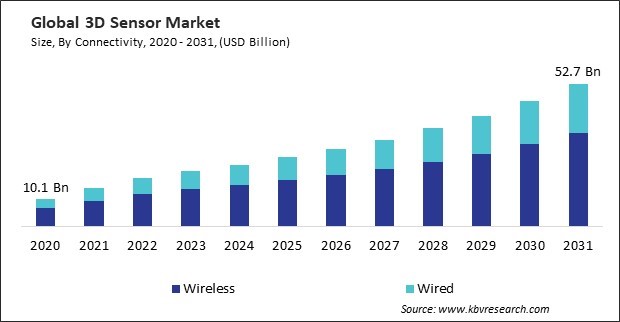
The major strategies followed by the market participants are Product Launches as the key developmental strategy to keep pace with the changing demands of end users. For instance, Sep-2024: Intel Corporation unveiled its Intel RealSense depth module line with the entry-level D421, designed for robotics applications. This all-in-one module integrates the D4 vision processor and offers a 75° × 50° field of view, 0.2 to 3 m range, and broad compatibility. Additionally, Jul-2024: STMicroelectronics N.V. unveiled the VL53L4ED, a high-accuracy Time of Flight proximity sensor with a temperature range of -40°C to 105°C. It measures distances up to 1300 mm with an 18° FOV and features a compact design, 940 nm laser emitter, and full C software driver compatibility, including Linux support.
Based on the Analysis presented in the KBV Cardinal matrix; Apple, Inc. is the forerunners in the 3D Sensor Market. Companies such as Texas Instruments, Inc., Samsung Electronics Co., Ltd., and Sony Corporation are some of the key innovators in 3D Sensor Market. In March, 2024, Samsung Electronics Co., Ltd. unveiled its 3D Map View feature in SmartThings, enhancing home management by converting floor plans into virtual images. This upgrade allows users to easily monitor and control connected devices like lighting and temperature in real-time, improving smart home usability and spatial understanding through Spatial AI and LiDAR technology.
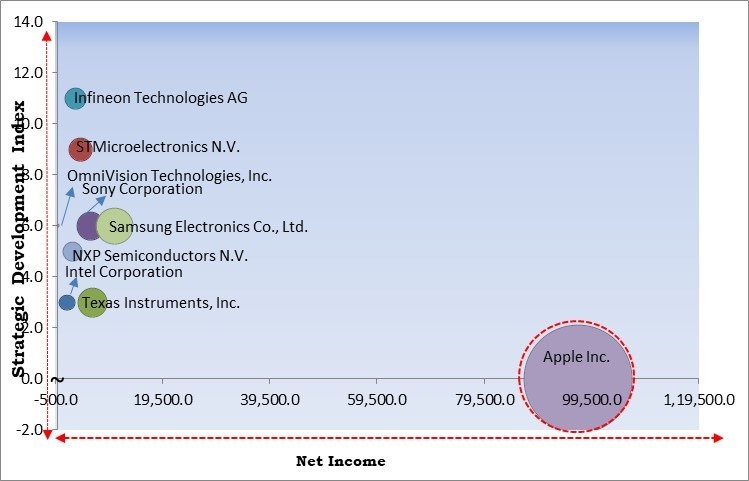
In security applications, detecting and tracking objects accurately is crucial. 3D sensors can identify shapes, sizes, and movements of objects, allowing for advanced tracking capabilities in crowded or complex environments. This feature is particularly beneficial for monitoring critical infrastructure, public transportation systems, and high-security areas, where precise tracking can prevent unauthorized access or detect suspicious behaviour. Hence, growing focus on enhanced security and surveillance solutions is propelling the growth of the market.
Modern manufacturing processes often involve complex tasks that traditional 2D sensors cannot effectively handle. 3D sensors provide depth perception and spatial awareness, essential for robotic pick-and-place operations, where robots must identify and handle items of varying shapes and sizes. This capability expands the range of applications for automation and robotics in manufacturing, driving further adoption of 3D sensor technologies. This interconnectivity improves the adaptability of manufacturing processes to changing conditions, further boosting the demand for 3D sensors. In conclusion, increasing demand for advanced automation and robotics in manufacturing processes is driving the growth of the market.
Different industries have varying budget constraints, impacting their ability to adopt new technologies. Sectors with tight profit margins, such as small-scale manufacturing, construction, or retail, may struggle to justify the high initial costs of 3D sensors. As a result, organizations in these industries might prioritize other investments over advanced sensing technologies, limiting market growth. Organizations may be cautious about investing in 3D sensor technologies due to uncertainty regarding their return on investment. The high initial costs can create hesitance, as businesses want to ensure that the benefits gained from implementing these technologies will justify the financial outlay. If the ROI is unclear or takes too long, companies may delay or forgo investments in 3D sensing solutions altogether. In conclusion, high initial costs of 3D sensor technologies are impeding the growth of the market.
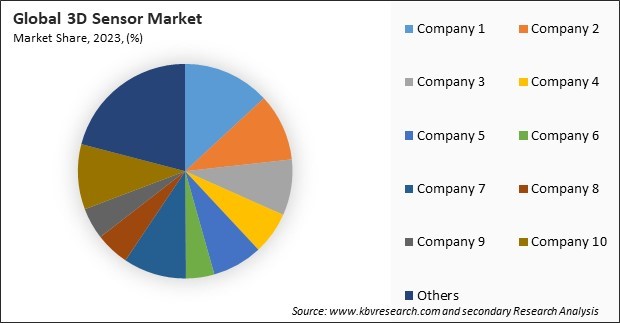
The leading players in the market are competing with diverse innovative offerings to remain competitive in the market. The above illustration shows the percentage of revenue shared by some of the leading companies in the market. The leading players of the market are adopting various strategies in order to cater demand coming from the different industries. The key developmental strategies in the market are Product Launches and Product Expansions.
Based on type, the market is divided into image sensor, accelerometer sensor, position sensor, and others. The position sensor segment witnessed 30% revenue share in the market in 2023. Position sensors are essential for the precise determination of the position of objects in space, rendering them indispensable in applications such as industrial apparatus, automotive systems, and robotics. The rise of automation and smart manufacturing has driven the demand for position sensors, as they play a key role in enhancing precision and efficiency.
On the basis of technology, the market is segmented into structured light, time of flight, stereoscopic vision, ultrasound, and others. The structured light segment recorded 30% revenue share in the market in 2023. This technology utilizes projected light patterns to capture the three-dimensional shape of objects, making it highly effective for applications requiring precise depth measurements and detailed surface information. Structured light sensors are widely used in automotive, robotics, and consumer electronics for quality inspection, object recognition, and gesture control tasks.
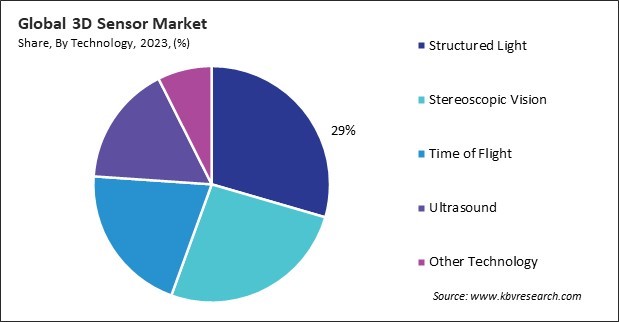
By connectivity, the market is divided into wireless and wired. The wired segment procured 33% revenue share in the market in 2023. Wired 3D sensors are known for their reliability, low latency, and stable performance, making them suitable for critical applications that require consistent data transmission and accuracy. Industries such as manufacturing, automotive, and healthcare often favour wired connections due to their robustness in environments where interference can be a concern.
Based on end use, the market is divided into aerospace & defense, automotive, healthcare, consumer electronics, and others. The consumer electronics segment attained 30% revenue share in the 3D sensor market in 2023. This can be attributed to the widespread integration of 3D sensing technologies in smartphones, tablets, gaming consoles, and smart home devices. The increasing consumer demand for enhanced user experiences through features like facial recognition, augmented reality (AR), and gesture control has driven significant investments in 3D sensors within this sector.
Free Valuable Insights: Global 3D Sensor Market size to reach USD 52.7 Billion by 2031
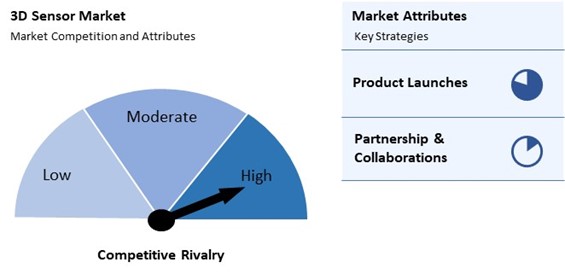
The Market is highly competitive, spurred by growing demand across sectors like consumer electronics, automotive, healthcare, and industrial automation. Providers are vying to offer sensors with enhanced accuracy, speed, and versatility to support applications like facial recognition, gesture control, and depth sensing. As industries increasingly adopt 3D sensing technology for advanced user experiences and precision measurement, competition centers on delivering sensors that are compact, energy-efficient, and capable of high-resolution data capture. Innovation in sensing technology and integration capabilities is crucial for maintaining a competitive edge.
Region-wise, the market is analyzed across North America, Europe, Asia Pacific, and LAMEA. The North America region witnessed 36% revenue share in the market in 2023. This can be attributed to major technology companies, extensive research and development activities, and a robust consumer electronics industry. The region’s focus on innovation and early adoption of advanced technologies has propelled the demand for 3D sensors across various sectors, including automotive, healthcare, and aerospace.
| Report Attribute | Details |
|---|---|
| Market size value in 2023 | USD 20.4 Billion |
| Market size forecast in 2031 | USD 52.7 Billion |
| Base Year | 2023 |
| Historical Period | 2020 to 2022 |
| Forecast Period | 2024 to 2031 |
| Revenue Growth Rate | CAGR of 12.7% from 2024 to 2031 |
| Number of Pages | 308 |
| Number of Tables | 482 |
| Report coverage | Market Trends, Revenue Estimation and Forecast, Segmentation Analysis, Regional and Country Breakdown, Competitive Landscape, Market Share Analysis, Porter’s 5 Forces Analysis, Company Profiling, Companies Strategic Developments, SWOT Analysis, Winning Imperatives |
| Segments covered | Connectivity, End use, Type, Technology, Region |
| Country scope |
|
| Companies Included | Sony Corporation, Infineon Technologies AG, Intel Corporation, STMicroelectronics N.V., NXP Semiconductors N.V., IFM Electronics GmbH, Apple Inc., OmniVision Technologies, Inc., Texas Instruments, Inc., Samsung Electronics Co., Ltd. (Samsung Group) |
By Connectivity
By End use
By Type
By Technology
By Geography
This Market size is expected to reach $52.7 billion by 2031.
Growing Focus on Enhanced Security and Surveillance Solutions are driving the Market in coming years, however, High Initial Costs of 3D Sensor Technologies restraints the growth of the Market.
Sony Corporation, Infineon Technologies AG, Intel Corporation, STMicroelectronics N.V., NXP Semiconductors N.V., IFM Electronics GmbH, Apple Inc., OmniVision Technologies, Inc., Texas Instruments, Inc., Samsung Electronics Co., Ltd. (Samsung Group)
The expected CAGR of this Market is 12.7% from 2024 to 2031.
The Wireless segment is leading the Market by Connectivity in 2023; thereby, achieving a market value of $34.4 billion by 2031.
The North America region dominated the Market by Region in 2023; thereby, achieving a market value of $18.6 billion by 2031.
Our team of dedicated experts can provide you with attractive expansion opportunities for your business.

 Drivers
Drivers
 Restraints
Restraints
 Opportunities
Opportunities
 Challenges
Challenges
